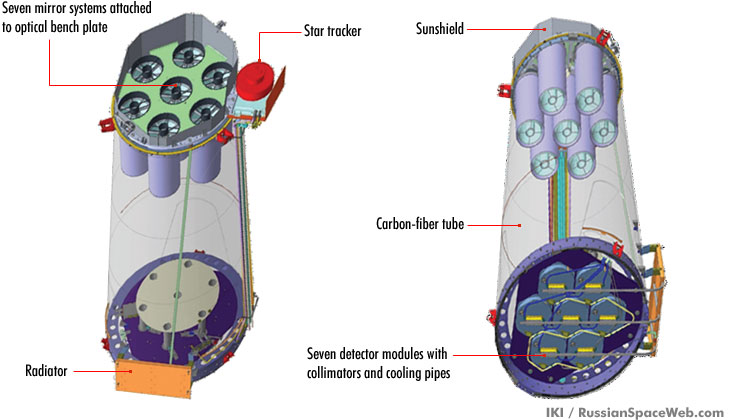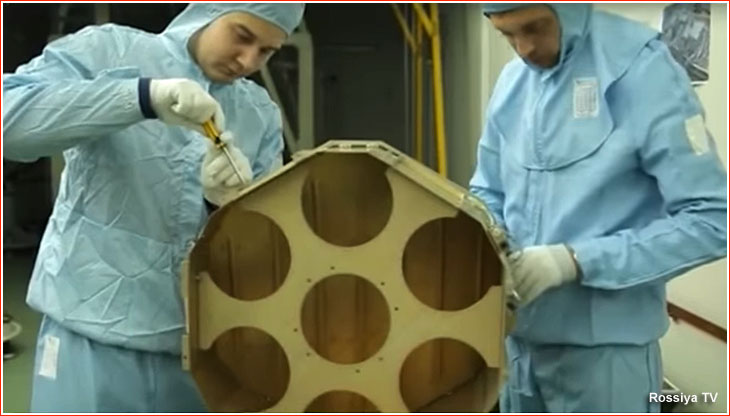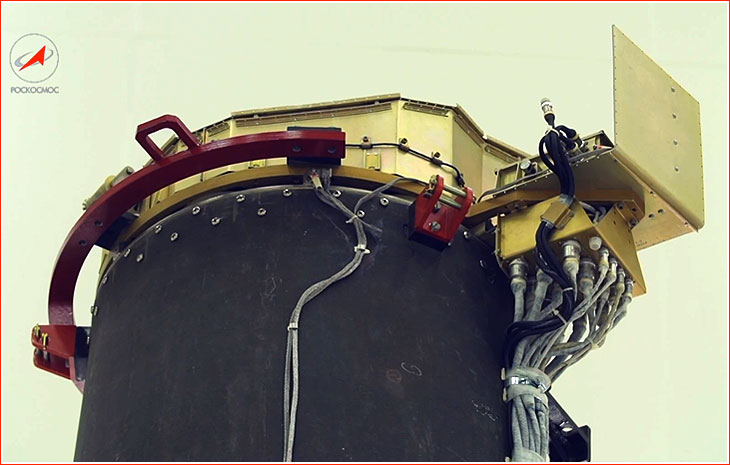ART-XC telescope to look at high-energy Universe
The primary Russian-built instrument aboard the Spektr-RG orbital observatory will be ART-XC, which stands for Astronomical Roentgen Telescope - X-ray Concentrator. Paired with the German eROSITA payload, ART-XC will have a narrower field of view and different though overlapping sensitivity range to X-rays emanating from space.
Previous chapter: eROSITA telescope for Spektr-RG


Overall design of the ART-XC telescope (top) and its detector modules with the cooling system. Credit: IKI
ART-XC at a glance (as of 2019):
| Sensitivity range |
5 - 30 keVolts |
| Angular resolution |
45 arc seconds |
| Field of view |
0.3 square degrees |
| Mass |
350 kilograms |
| Power consumption |
300 Watts |
| Number of mirror modules |
7 |
| Number of mirror shells per each module |
28 |
| Mirror shell length |
580 millimeters |
| Mirror shell diameters |
from 49 to 145* millimeters |
| Focal length |
2,700 millimeters |
| Mirror material |
Nickel and cobalt |
| Mirror coating |
Iridium |
| Detector type |
DSSD, CdTe |
| Detector size |
30 by 30 millimeters |
| Detector operating temperature |
-20 degree C |
| Sensor area (grasp) |
450 square centimeters per 8 keVolts |
ART-XC design
The ART-XC telescope was developed under the leadership of Mikhail Pavlinsky at the Space Research Institute, IKI, of the Russian Academy of Sciences in Moscow. The Russian Federal Nuclear Center, NIYaF-VNIIEF, in the town of Sarov developed the structure of the telescope and its mirror system and also assisted with several phases of the instrument's testing.
According to original plans, the telescope was expected to have a pair of four-mirror clusters, before a single seven-mirror cluster design was chosen.
In a rare example of the Russian space institutions contracting the US space agency for the supply of sophisticated technology, NASA's Marshall Space Center developed and calibrated critical mirror systems for the ART-XC, which were then integrated into the telescope at NIYaF-VNIIEF.
The optical system of the ART-XC includes seven clusters of 28 nested conical mirror shells with a length of 580 millimeters and a maximum diameter of 148 millimeters.
The mirrors will concentrate the captured X-rays toward the focal points where the telescope carries special semi-conductor detectors, known as Double-sided Silicon Strip Detectors, DSSDs, made of cadmium telluride (CdTe). These particular devices were designed, built and calibrated at the Department for High-Energy Astrophysics of the IKI institute. Each of the seven detector units has a 30 by 30-centimeter sensor with a thickness of 1 millimeter.
For the ART-XC instrument, IKI also supplied an onboard computer and data memory system, an avionics unit for temperature control and a star tracker for the telescope's guidance.
NPO Lavochkin, which served as the primary integrator in the Spektr-RG project, also provided thermal blankets, the radiator system and heat pipes for the telescope's thermal control system.
Finally, NPO Tekhnologiya built the carbon-fiber tube of the telescope and the plate holding its detectors.

A photo of ART-XC detectors released in 2019.
Scientific program
The ART-XC telescope will expand the range of its sister eROSITA telescope toward higher-energy radiation reaching 30 kilo-electron volts. The overlap in the sensitivity of eROSITA and ART-XC was reported to be useful for the calibration of the two instruments and increasing the reliability of their scientific results.
ART-XC will be employed to produce a record-breaking map of the entire sky in the range of 5 to 11 kiloelectron volts and scan the ecliptic pole regions of the sky at the range of 5 to 30 kiloelectron volts.
At that range, the interstellar medium, which filters the X-rays before they can reach the observatory, has lower absorption effect on radiation fluxes in comparison to less energetic waves. When combined with high angular resolution, this property of the instrument becomes essential for the reliable detection and localization of hard X-ray emissions. The resulting data was predicted to reveal more than one thousand galactic nuclei and several thousand growing super-massive black holes hidden from viewers on Earth by thick clouds of dust and gas concentrating around accretion discs.
ART-XC also promises to provide the first simultaneous view of a large selection of accreting white dwarfs and allow the measurument of their masses among other parameters.
The instrument was also designed to image X-ray sources with changing brightness (known as transient X-ray sources), which can reveal new types of objects.

A bench plate of the ART-XC telescope during assembly in Sarov circa 2017.

An aperture section of the ART-XC telescope.
|